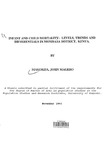| dc.contributor.author | Makokha, John M | |
| dc.date.accessioned | 2013-05-04T12:27:48Z | |
| dc.date.available | 2013-05-04T12:27:48Z | |
| dc.date.issued | 1993 | |
| dc.identifier.citation | A thesis submitted in partial fulfilment of the requirements for the degree of Master of Arts in population studies at the | en |
| dc.identifier.uri | http://erepository.uonbi.ac.ke:8080/xmlui/handle/123456789/19055 | |
| dc.description.abstract | Man's prime concern is the sustenance of good and long life. Although death at any age deals a major blow to the realization of this goal, the death of infants and children is much more agonizing because it represents the destruction of both hope and immense potential for the future.
This study analyses infant and child mortality in Mombasa district. These target groups were selected for this study because they reflect the success level of the health care programmes. The main objective of the study was to estimate and describe infant and child mortality levels,trends and differentials in Mombasa district by divisions. Specifically the impact of the educational level of the mothers as well as the marital status on infant and child mortality have been measured. The database for this study was extracted from the 1979 National population census in Kenya. The Brass-Trussell indirect analytical technique has been used to estimate mortality levels and generate life table functions.
Mombasa district being predominantly urban, it would be expected to experience comparatively low mortality because of the availability of many medical facilities and services. However this study has revealed fairly high infant and child mortality in Mombasa. The mother's division of residence affect both mortality and life expectancy. The Island division with better facilities and services experience low mortality with consequent high life
expectancy. In all the divisions, mortality was found to decrease
with the increase in the level of education of the mothers. This relationship can be explained by the associated higher incomes of the mother's of higher education and their higher levels of awareness especially about medical care and nutrition. Analyzed by marital status, infant and child mortality was found to be highest among the widowed. For all the differentials and in all the divisions, mortality during infancy was found to be higher than mortality occurring between ages one and five.
Policy programmes aiming at the reduction of infant and child mortality in the district should focus on increasing and making more accessible health facilities,services and general infrastructure. Both formal and informal education are quite useful too especially for females. The socio-cultural dimension and it's effect on infant and child mortality requires a more detailed
study. | en |
| dc.language.iso | en | en |
| dc.title | Infant and chilld mortality: levels, trends and differential in Mombasa District, Kenya. | en |
| dc.type | Thesis | en |
| local.publisher | Department of Arts-institute of population studies and research | en |

